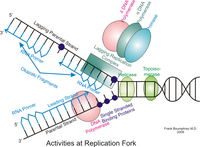
Photo from wikipedia
We study the assembly of DNA-functionalized nanocubes under lateral confinement in microscale square trenches on a DNA-functionalized substrate. Microfocus small-angle X-ray scattering (SAXS) and scanning electron microscopy (SEM) are used… Click to show full abstract
We study the assembly of DNA-functionalized nanocubes under lateral confinement in microscale square trenches on a DNA-functionalized substrate. Microfocus small-angle X-ray scattering (SAXS) and scanning electron microscopy (SEM) are used to characterize the superlattices (SLs). The results indicate that nanocubes form simple-cubic SLs with square-prism morphology and a (100) out-of-plane orientation to maximize DNA bonding. In-plane, SLs align with the template, exposing their {100} side facets, and the degree of alignment depends on trench size. Interestingly, the distribution of in-plane orientations determined from SAXS and SEM do not agree, indicating that the internal and external structures of the SLs differ. To understand this discrepancy, X-ray ptychography is employed to image the internal structures of the SLs, revealing that SLs which appear to be single-crystalline in SEM may have subsurface grain boundaries, depending on trench size. SEM reveals that the SLs grow via nucleation and growth of randomly oriented domains, which then coalesce; this mechanism explains the observed dependence of alignment and defect structure on size. Interestingly, crystallization occurs via an unusual growth mode, whereby continuous SL layers grow on top of several misoriented islands. Overall, this work elucidates the effect of lateral confinement on the crystallization of DNA-functionalized nanoparticles and shows how X-ray ptychography can be used to gain insight into nanoparticle crystallization.
Journal Title: ACS nano
Year Published: 2022
Link to full text (if available)
Share on Social Media: Sign Up to like & get
recommendations!